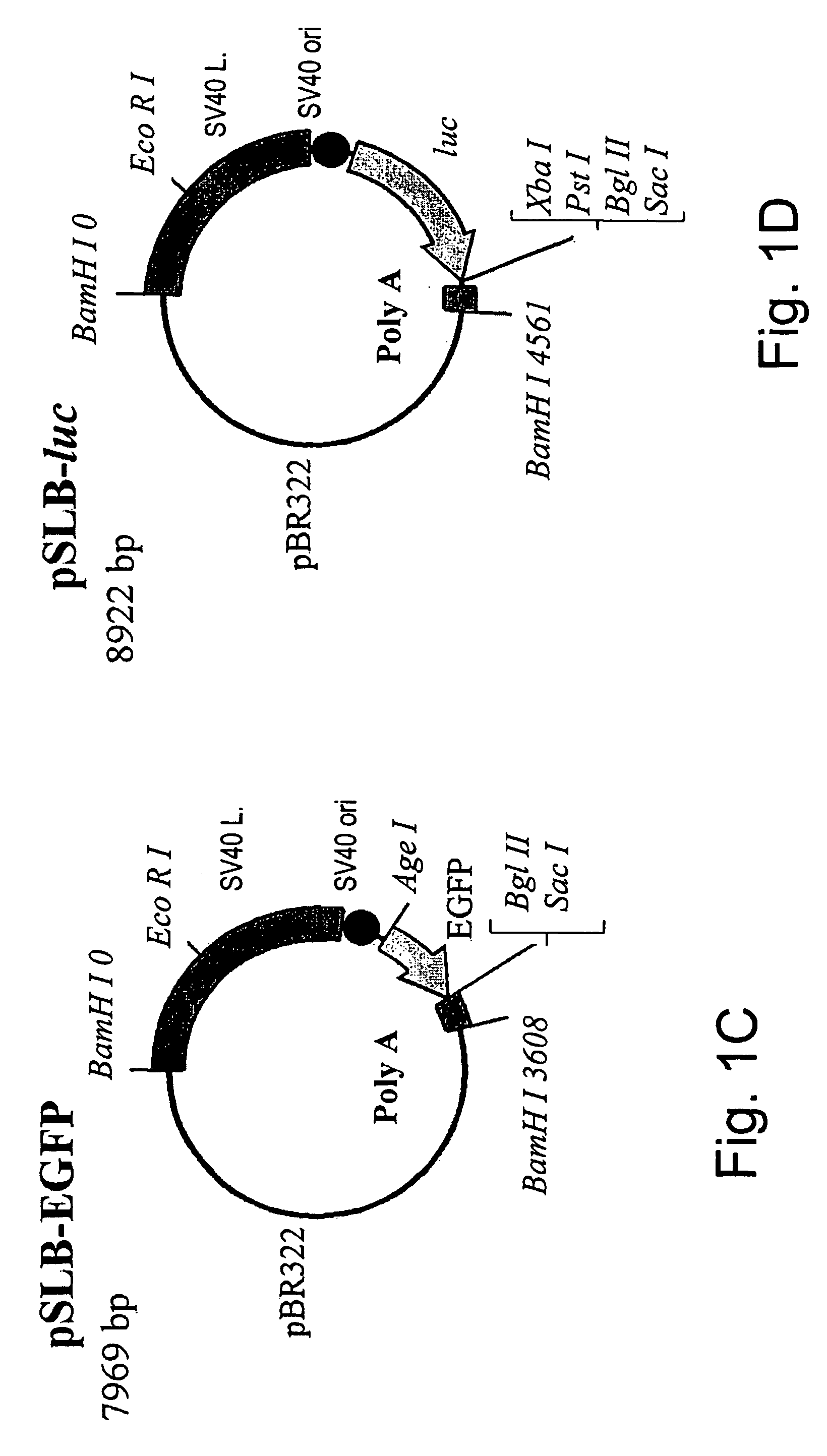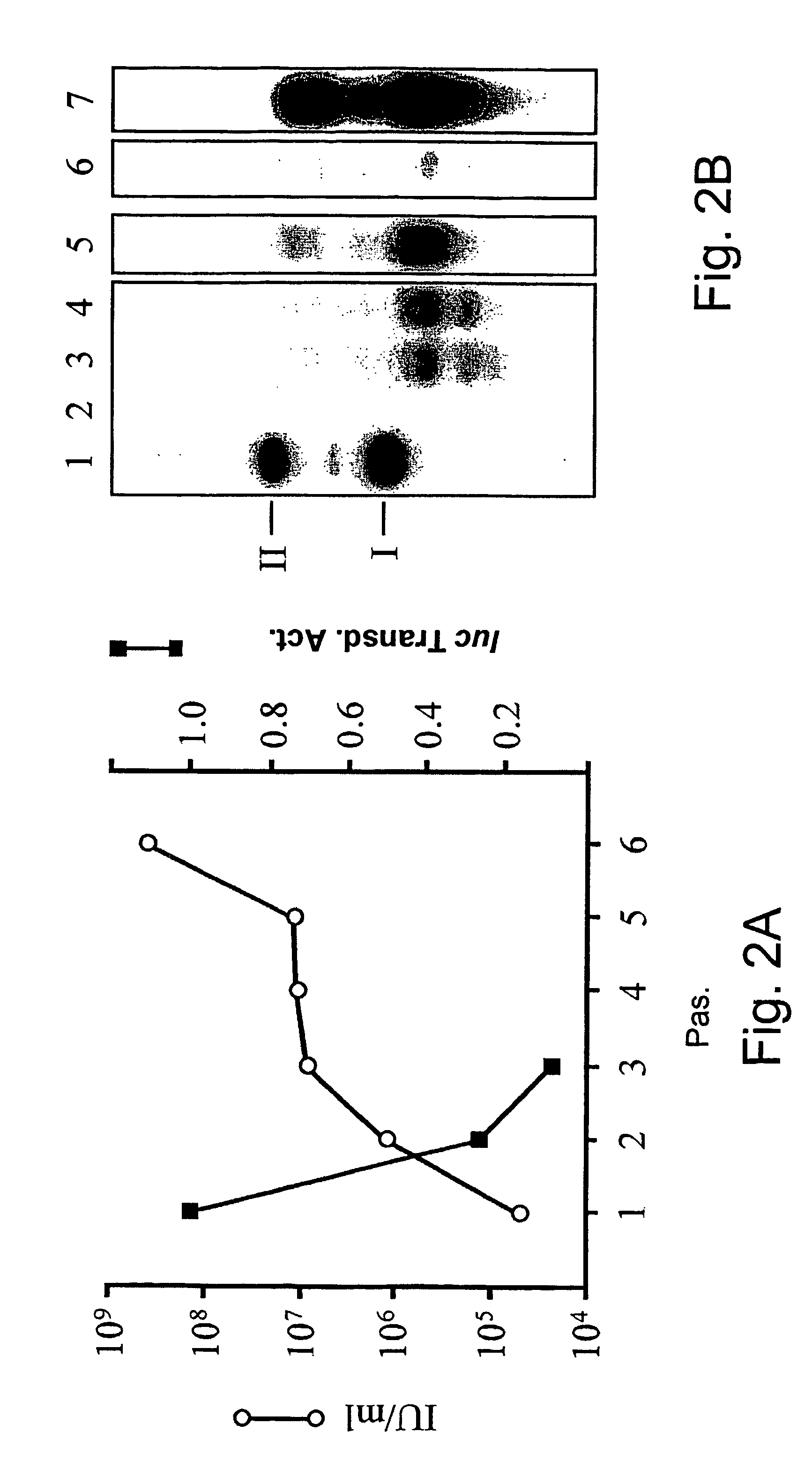Packaging complementation cell-line for sv-40 vectors
a technology of sv40 and packaging cell line, which is applied in the direction of dsdna viruses, genetic material ingredients, viruses/bacteriophages, etc., can solve the problems of affecting the effectiveness of currently available viral gene transfer vectors, affecting the production of t-antigen sequences, and reducing the production of sv40 wildtype free packaging cell lines
- Summary
- Abstract
- Description
- Claims
- Application Information
AI Technical Summary
Benefits of technology
Problems solved by technology
Method used
Image
Examples
example 1
Propagation of SV40 Vectors in CMT4 Cells Results in Emergence of Replication-Competent Virus and Loss of Transducing Activity
[0192] In CMT4 cells, a 653-bp fragment of the mouse metallothionein promoter has been placed upstream to the T-antigen coding sequence, leaving sequence identity with the vector only downstream to the gene. The present inventors have speculated that eliminating sequence identity at one end of the T-antigen gene would significantly reduce the level of double crossover events and the generation of T-antigen positive recombinants.
[0193] SV40 vectors carrying the luc transgene, SV / luc, prepared from plasmid pSLB-luc were propagated by passaging in CMT4 cells, as described in Materials and Methods. Vector stocks were titered for infectious units (IU) as infective centers on CMT4 monolayers [Dalyot-Herman, ibid. (1996)] and in parallel tested for their ability to transduce COS-1 cells. The titer of IU increased with repeated passaging (FIG. 2A) but unexpectedly ...
example 2
Construction of a T-Antigen Expression Cassette Containing Minimal Homology to SV40 Vector Sequences
[0195] SV40 vectors contain sequences that include the overlapping early and late polyadenylation signals, up to the Bcl I site at SV40 coordinate 2770, including a 77 bp overlap with the T-antigen coding region (FIG. 1B). The early polyadenylation signal is usually utilized for transgene expression, and the late, that is in closer proximity to the T-antigen coding sequence, for expression of the capsid proteins required for vector production. Hence, development of a packaging cell-line that supplies the T-antigen in trans, without any sequence identity to the vector, requires modifications of the vector itself. Plasmid PUMTB (FIG. 1A), in which T-antigen transcription is driven by the mouse metallothionein promoter and utilizes the bovine growth hormone polyadenylation signal, have been constructed. This strategy limits the identity between the packaging cell-line and the vector seq...
example 3
Isolation of Cell-Lines that Carry an Inducible T-Antigen
[0197] The bacterial sequences were excised off PUMTB. The linearized expression cassette was transfected into CV-1 and Vero cells, together with a linear neoR expression cassette which does not contain any SV40 sequences, derived from pLN [Miller, A. D. and Rosman, G. J. Biotechniques 7, 980-990 (1989)]. Forty-eight hours post transfection cells were replaced in selective medium containing G418 for 3 weeks, until antibiotic resistant colonies could be isolated. Individual colonies were expanded and screened for T-antigen expression by RNA analysis. Five of the CV-1 clones and 3 of the VERO clones expressed elevated T-antigen RNA in response to metal induction.
[0198] These cell-lines were then evaluated for their ability to package SV40 vectors. SV / GFP vector DNA was excised with BamH I from pSLB-GFP (FIG. 1C), then circularized by self-ligation and transfected into expanded clones. The SV / GFP viral vectors were harvested by...
PUM
| Property | Measurement | Unit |
|---|---|---|
| concentration | aaaaa | aaaaa |
| total volume | aaaaa | aaaaa |
| resistance | aaaaa | aaaaa |
Abstract
Description
Claims
Application Information
 Login to View More
Login to View More - R&D
- Intellectual Property
- Life Sciences
- Materials
- Tech Scout
- Unparalleled Data Quality
- Higher Quality Content
- 60% Fewer Hallucinations
Browse by: Latest US Patents, China's latest patents, Technical Efficacy Thesaurus, Application Domain, Technology Topic, Popular Technical Reports.
© 2025 PatSnap. All rights reserved.Legal|Privacy policy|Modern Slavery Act Transparency Statement|Sitemap|About US| Contact US: help@patsnap.com



